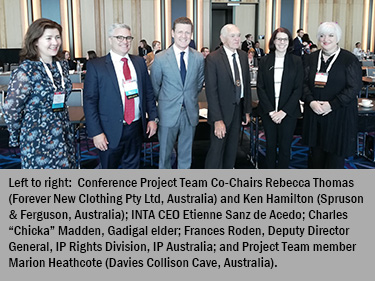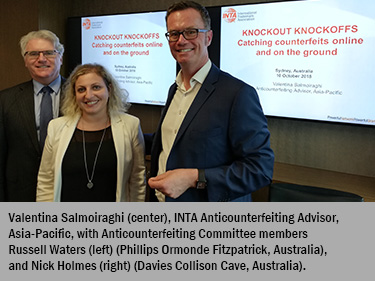Looking Beyond Trademarks: A Report from INTA’s 2018 Asia-Pacific Conference
Published: November 1, 2018
David Moore Henry Hughes IP Wellington, New Zealand
 More than 200 delegates gathered in Sydney, Australia, for INTA’s intensive and productive two-day 2018 Asia-Pacific Conference: Looking Beyond Trademarks, from October 11 to 12. The conference covered an exciting balance of traditional trademark material (for example, anticounterfeiting strategies and enforcing trademark rights against unauthorized ad words and metatags) together with highly informative sessions on hot topics such as data privacy, corporate social responsibility, 3D printing, and ambush marketing.
More than 200 delegates gathered in Sydney, Australia, for INTA’s intensive and productive two-day 2018 Asia-Pacific Conference: Looking Beyond Trademarks, from October 11 to 12. The conference covered an exciting balance of traditional trademark material (for example, anticounterfeiting strategies and enforcing trademark rights against unauthorized ad words and metatags) together with highly informative sessions on hot topics such as data privacy, corporate social responsibility, 3D printing, and ambush marketing.
Themes
Several key themes emerged over the two-day conference. In particular, the benefit of working in partnership was a recurring message. Brand owners can strengthen their position against infringers by working in partnership with border protection officials, intellectual property (IP) offices, and online retailing platforms.
INTA CEO Etienne Sanz de Acedo spoke in his opening address about INTA’s desire to embrace innovation and to assist its members in doing likewise. This became another theme, as the IP offices of Australia, New Zealand, and Singapore are planning ahead to ensure that their systems are equipped to meet the changing pace of innovation. Attorneys and brand owners must also adapt to new technologies.
As the title of the conference suggests, registrants were invited to move beyond trademarks. Mr. Sanz de Acedo asked them to move from thinking in terms of trademarks to thinking about brands, and they were challenged to broaden their knowledge of non-trademark topics, such as data privacy and 3D printing.
Knockout Knockoffs
Early birds kicked off the week on October 10 with a three-hour policy discussion on anticounterfeiting titled “Knockout Knockoffs-Catching Counterfeits Online and on the Ground” held at the office of Davies Collison Cave and organized by INTA’s Anticounterfeiting Committee-East Asia and Pacific Subcommittee. The discussion began with opening remarks from Valentina Salmoiraghi, INTA’s Anticounterfeiting Advisor, Asia-Pacific, who touched on the activities of the Anticounterfeiting Committee in the region. Organizing members Nick Holmes (Davies Collison Cave, Australia) and Russell Waters (Phillips Ormonde Fitzpatrick, Australia) then set the stage for the discussion and emphasized the importance of holding collaborative dialogues.
The discussion commenced with a panel on “Border Measures: Challenges and Successes” moderated by Russell Waters (Phillips Ormonde Fitzpatrick, Australia). Remarks from the Australia Border Force and presentations and videos by brand owners on the dangers of counterfeits were shown. Additionally, sobering video footage from Nicolas Green (Australian Federal Chamber of Automotive Industries, Australia) and Shoba White (Toyota, Australia) demonstrated the severity of the consequences of purchasing counterfeit car parts. Worryingly for consumers, the fakes can be very difficult to spot even by people in the industry.
The second panel of the day, “Best Practices in Combatting Online Counterfeiting,” was moderated by Nick Holmes (Davies Collison Cave, Australia). Both Michelle Fahey of New Zealand’s leading online sales platform, Trade Me, and Stacey Taylor, Head of Legal, Australia and New Zealand, at eBay (Australia), spoke about their respective company’s takedown procedures. Both platforms are very open to working with brand owners, forming  industry partnerships, and cooperating with authorities to remove listings for fake goods as efficiently as possible.
industry partnerships, and cooperating with authorities to remove listings for fake goods as efficiently as possible.
Rodney Jeffs of the Australian Department of Home Affairs (Border Force Department) observed how few border protection notices are in place compared to the number of registered trademarks in the country, highlighting that customs and border protection officials need help from brand owners in order to operate more effectively.
Bruce Tonkin (.au Domain Administration Ltd., Australia) and Luke Richards (Clarivate, Australia) rounded out the dialogue with a discussion of the importance of cooperation between the public and private sectors and available solutions to implement consumer safeguards.
Conference Welcome and Keynote Address
Registrants were privileged to be welcomed to Sydney by Charles “Chicka” Madden, an elder of the Gadigal people. The Gadigal clan are part of the Eora Nation-the coastal aboriginal peoples who have lived in and around the Sydney region for many thousands of years.
The conference keynote address was delivered by Louise Baxter, the Chief Executive and Executive Director of the Starlight Children’s Foundation (https://starlight.org.au/). Starlight is a charitable organization that creates “positive distractions” for seriously ill children and their families. Ms. Baxter talked about the power of one’s personal brand and a company’s brand. A strong brand starts with clarity: establish your purpose and vision and then cascade it through your entire business. Ms. Baxter reminded the audience that everything you do will either underpin, or undermine, your brand.
The Role of IP Offices
Registrants next heard from Frances Roden, Deputy Director General, IP Rights Division of IP Australia; Paula Adamson of IP Australia; Steffen Gazely of the Intellectual Property Office of New Zealand; and Kok Wan Ng from the Intellectual Property Office of Singapore (IPOS). All three IP offices have strategic plans in place looking toward the future. In addition to ensuring that they are embracing new technologies and using those technologies to provide a better service, the IP offices are looking to play a role in supporting and educating local businesses to grow their IP capabilities. This may mean that businesses are better equipped to manage their own trademark portfolios directly with the IP offices. Trademark attorneys may need to broaden the value that they can offer to innovative companies rather than just relying on routine trademark filings.
Amid the talk of revolutionary technological change, Mr. Ng of IPOS asked registrants to think back to 2008. What has changed since then? Many things are in fact still the same. There are different paces of change. One thing which will not change is the need for consumers to trust the brands with which they interact.
A featured speaker was Christian Archambeau of the European Union Intellectual Property Office (EUIPO). Mr. Archambeau is the newly appointed director of EUIPO and was performing his first speaking engagement in his new role. In keeping with the theme of collaboration and partnership, Mr. Archambeau spoke of EUIPO’s work with IP Australia on new technology and big data, and its cooperative programs in Southeast Asia, India, and Latin America. EUIPO’s future plans include accelerating the use of new technologies, supporting small and medium-sized enterprises (SMEs), and enhancing enforcement capabilities.
Trademark Sessions
In a session on regulatory restrictions that are being placed on brands, Mr. Sanz de Acedo emphasized that INTA’s role is to promote the rights of brand owners and consumer protection. The implementation of brand restrictions, such as plain packaging of tobacco, which started in Australia, has spread to other countries. Now, restrictions are being considered beyond tobacco for products such as sugary drinks, high fat content foods, and breakfast cereals. It is not just brand owners who stand to lose billions of dollars in brand value; there is a flow-on effect to the creative industries that design logos and packaging, leading Kylie McPherson (Diageo, Australia Ltd) to ask the important question whether the product label is the most effective way to educate consumers about health?
In other sessions, registrants learned about taking enforcement action in South Korea, Japan, and China against the misuse of trademarks as ad words or metatags. They also heard from representatives of two high-profile brands, Wendy P. Collie (Mars, Incorporated, Australia) and Huong Nguyen (Tiffany & Co, Australia), about the challenges of battling counterfeit goods online and offline, defense strategies and tools. Only a small percentage of products coming into a country are x-rayed. Working and partnering with and training customs officials is a key part of any strategy.
Beyond Trademarks
Project Team Co-chairs Rebecca Thomas (Forever New Clothing Pty Ltd, Australia) and Ken Hamilton (Spruson & Ferguson, Australia) should be commended for leading a team which, collectively, put together a highly stimulating program.
George Chan (Simmons and Simmons, China) led a session on establishing an online trading channel in China. The speakers gave first-hand, practical tips on how to avoid rookie mistakes and protect their IP.
Registrants also heard from representatives of Telstra-Australia’s leading telecommunications provider-on balancing data collection versus privacy rights on a global scale.
Peter Chalk (Ashurst, Australia) interviewed Heather Forrest, Chair of ICANN’s Generic Names Supporting Organization (GNSO). The interview was wide-ranging, covering the history of the collection of and access to WHOIS data, and what the European Union’s General Data Protection Regulation (GDPR) could mean for the future.
Other sessions focused on the positive benefits to business in having an effective corporate social responsibility policy, the mind blowing possibilities of 3D printing, and the tensions that arise among sponsors, athletes, and opportunistic marketers around major sporting event.
Importantly, given the warm welcome from the Gadigal people, registrants heard from Terri Janke (Janke and Company Pty Ltd, Australia), Kerry Silcock (IP Australia, Australia), Karaitiana Tairu (Trade Marks MÄ
This website uses cookies so that we can provide you with the best user experience possible. Cookie information is stored in your browser and performs functions such as recognising you when you return to our website and helping our team to understand which sections of the website you find most interesting and useful.
To find out more please see our Cookies Policy and Privacy Policy.
These cookies are used to identify a user’s browser as the visitor goes from page to page on the Site. These are session cookies, which means that the cookie is deleted when you leave the Site. It is an integral piece of the Site software and used to let the server know which users are on the Site at any given time and make certain parts of the Site easier to use.
|
|
If you disable this cookie, we will not be able to save your preferences. This means that every time you visit this website you will need to enable or disable cookies again.
These cookies are used to collect information about how visitors use our Site. The cookies collect information in anonymous form, including the numbers of visitors to the Site, where visitors have come to the Site from, the pages they visited and how they have interacted with tools on the Site like search and embedded media players. We use the information to compile statistical reports of our users’ browsing patterns so that we can improve the Site.
|
|
Please enable Functionality Cookies first so that we can save your preferences!
These cookies are used to deliver advertising relevant to the interests of visitors to our Site. They are persistent, which means they will remain on your device after you leave the Site.
- Facebook (Ad Pixel)
- Google (Ad Pixel)
- LinkedIn (Ad Pixel)
- Quattro Anonymous
Please enable Functionality Cookies first so that we can save your preferences!
